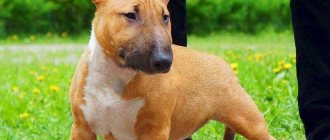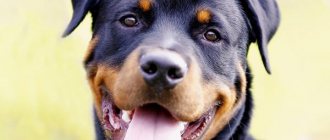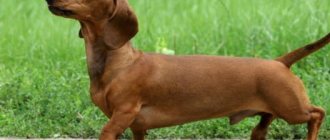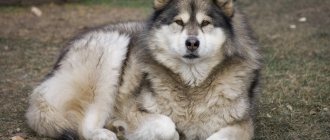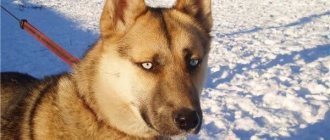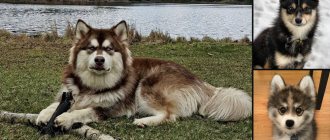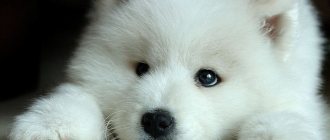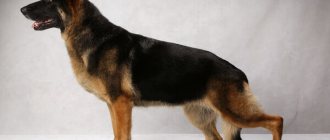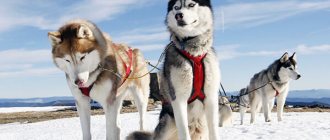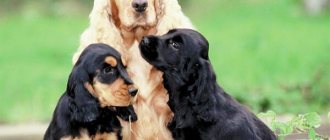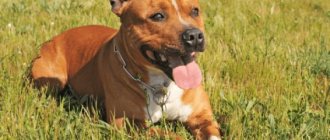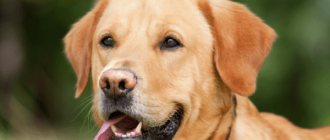Huskies are one of those dogs whose appearance cannot go unnoticed.
It is thanks to its beautiful exterior that many people want to get such a pet, but there is no need to rush.
Representatives of this breed have a rather complex character, so before buying a puppy you should read the description of the breed and reviews of the owners in order to have an idea of the breed as a whole and evaluate your strengths.
Description of the breed
The Husky has a harmoniously built muscular body, straight limbs, well-muscled hips and oval, compact paw pads.
To meet the breed standard, dogs must have:
- head proportional to the body of medium size;
- slightly rounded skull, tapering towards the eyes;
- a clearly defined transition from the forehead to the not very long muzzle;
- slanted almond-shaped eyes, which can be blue, blue, gray or brown, are often found in individuals with heterochromia;
- medium-sized V-shaped ears with slightly rounded tips;
- black, brown or gray, depending on coat color, nose;
- scissor bite;
- deep and wide chest;
- straight back.
Adult males grow to 53.5-60 cm at the withers with a weight of 20.5-28 kg, the height of females is 50.5-56 cm, and body weight is 15.5-23 kg.
Character traits
Huskies can be described as affectionate, good-natured dogs and not prone to aggression. They are very sociable, friendly and need constant attention.
Representatives of this breed are people-oriented and become attached to their owner . At the same time, they will not remain faithful to one person if that person does not constantly prove to them his leadership and shows disrespect for the pet.
These dogs are accustomed to existing with people on an equal footing, being their partners and companions, and will not tolerate disdainful treatment.
Huskies have a complex and obstinate character, which not everyone can cope with . They are characterized by stubbornness, willfulness, independence and the desire to dominate.
Many husky character traits are inherited.
Features of training
For all their friendliness, huskies are very capricious dogs. You should immediately abandon the idea of using the “carrot and stick” method. Any violence is completely inapplicable and ineffective towards this breed.
The most important thing is strict authority. The dog must know who is in charge in this relationship.
The next principle, rather of education than training, is the same rules of behavior for everyone. All family members should equally encourage or discourage any behavior. If a dog is not allowed to sleep on the sofa, then everyone should prohibit it, otherwise there will be complete confusion in his head.
Repeating commands multiple times and rewarding them for their execution is the key to quickly and efficiently mastering them.
The question of how to raise a husky should be asked before the puppy arrives in the house. Training should begin when he reaches the age of 3-4 months.
Advantages and disadvantages
The main advantages of huskies that the owners of these dogs, especially those who have small children, talk about are their friendly disposition, lack of aggression and the ability to get along with kids..
In addition, representatives of this breed have an attractive appearance, good health and a high degree of endurance.
Also husky:
- know how to find a common language with other pets;
- do not have an unpleasant odor;
- sociable;
- independent;
- clean;
- smart and quick-witted;
- adapt well to new conditions.
Speaking about the disadvantages of the breed, it should be noted that these dogs:
- stubborn and willful;
- prone to dominance;
- shed heavily;
- cannot stand loneliness;
- prone to prolonged howling, digging holes and escapes;
- do not tolerate heat well;
- need constant communication.
Huskies do not have guarding or guarding instincts, so they should not be bred to guard the house.
What is the price
Buying a Husky puppy is not as simple a task as it might seem. Firstly, you cannot always trust advertisements posted on various Internet resources. And secondly, it is not so easy to find a large nursery that breeds and sells. On average, a puppy without pedigree, documents and distinctive physical abilities costs about thirty thousand rubles.
The presence of documents immediately increases the cost by ten thousand rubles. Well, if you are interested in compliance with all standards and formalities, the puppy’s involvement in a famous dynasty, participation in exhibitions, etc., then the price will start from fifty thousand rubles. Such promising kids, showing artistic abilities , are immediately visible.
But if you are a beginner, then it is better to look for a good and reliable friend from ordinary puppies . In order to win exhibitions and create your own show programs, it is not enough to buy a promising artist, you still need to be able to grow him into a real star.
Is it suitable for living in an apartment?
Huskies are large dogs, the height of males at the withers reaches a maximum of 60 cm, and females - 56 cm, so they can be kept in city apartments.
At the same time, we must not forget about the hyperactivity of these animals and their need for physical activity. Therefore, in the case of apartment living, they must be walked at least 2 times a day for 1.5-2 hours.
Is it suitable for outdoor use? Can it protect the house?
Representatives of this breed have a two-layer coat consisting of hard guard hairs and soft, dense undercoat, thanks to the thickness of which they can easily tolerate even severe frosts down to -50-60 °C.
Therefore, huskies can live outside without any problems throughout the year . They only need a spacious, equipped enclosure that does not limit their freedom.
It is also important that there is a canopy in the yard, under which in the summer the dog can hide not only from bad weather, but also from the sun, since heat, unlike frost, is difficult for huskies to endure.
CAREFULLY!
These dogs are not suitable for being kept on a chain.
Representatives of this breed do not have a guard instinct, so you should not have them as house guards.
Provided they are properly raised, they can be trained to guard the territory, but this will manifest itself in no more than warning the owners about the visit of strangers.
Interesting Facts
- When going bear hunting, Eskimos always took huskies with them.
- The dog's special coat has virtually no odor and helps work at temperatures down to –60 °C.
- Huskies are exceptionally hardy: in a day they can run more than 250 km in a harness.
- Scientists believe that the Siberian Husky breed has a hidden mechanism for reducing metabolism, which allows them to work for a long time without succumbing to fatigue.
- The first dog of the Siberian Husky breed was imported to the USA in 1908 and this saved the breed from extinction, since in the USSR these dogs were considered useless and were not distinguished as a separate breed.
- It was the huskies who brought the medicine for diphtheria to the city of Nome, which helped stop the epidemic in Alaska in 1925.
- In 1995, polar explorer Pavel Smolin climbed with a team of husky dogs to Peak Communism (7495 m). Earlier in 1990, the scientist conquered Lenin Peak (7145 m) using dogs of a different breed. For these achievements, Pavel Smolin was included in the Guinness Book of Records.
- The story of the city's salvation became the basis for the cartoon "Balto" and its sequel. Although in fact Balto was only one of 150 huskies who participated in the delivery of the serum.
- In New York, a statue of a dog was erected in honor of the feat of Balto and the rest of the sled dogs.
- Huskies rarely bark, but more often howl or purr.
How active is the breed? What kind of people is it suitable for?
Huskies have never been a decorative breed; they were bred exclusively for hard work, which required endurance and energy..
Despite the fact that these dogs have not been used for work for a long time, nothing has changed: they are still energetic animals, characterized by hyperactivity and the need for physical activity.
Wherever huskies live - in an apartment or on the street - they need regular long walks, including active games, physical activity and elements of training.
These dogs will be ideal pets for people who prefer to lead an active lifestyle and have a strong character, willpower and unconditional leadership qualities necessary to raise a dog.
Historical reference
Since ancient times, in the territory of modern Siberia and the Far East, settled tribes engaged in hunting and fishing bred dogs. Some ancient sources even called these places “The Land of Dogs.” Over time, the need for such animals only increased. With the development of trade relations, there was a need for sled dogs for cargo transportation. This is how the ancestors of modern huskies appeared.
At the beginning of the last century, during the time of gold miners, Siberian huskies became faithful companions of seekers of wealth and adventure. The dogs were strong, hardy and fast, and were distinguished by their extraordinary friendliness.
Such animals appealed to all residents of Alaska. Later they began to be used for sporting purposes. This is how the history of dog sled racing began. A special husky harness was put on the animal, then they were united into one team and carried the rider on a special sleigh.
This sport forced people to improve their dog's racing abilities. Over time, mixed breeds appeared in the world.
Today, all dogs in this group can be divided into sled dogs, show dogs and working dogs.
How to feel about loneliness
They are sociable dogs that have lived in packs throughout their history, so they need constant interaction with people and other animals.
You cannot limit the communication of huskies and isolate them . Spending a long time alone has a negative impact on the health and mental state of these dogs.
Who to choose - a boy or a girl?
When choosing between a dog and a bitch, you should know that their character and temperament have some differences.
Girls are more affectionate, obedient and flexible, they are easier to train . They have a softer and calmer character, but at the same time they are cunning and capable of many tricks to get what they want.
In addition, during estrus, the character and behavior of the pet may change, and its performance decreases.
Boys are calmer, more resilient and strong . They are not characterized by cunning, they are honest and straightforward, and tend to openly demonstrate their desire to be the leader of the “pack.”
Despite the friendly disposition inherent in the breed, they can show aggression towards foreign males in order to defend their leadership and superiority.
Dog habits
Habits can be physiological, age-related or psychological:
- So, for example, during the period of changing teeth, you can notice your pet’s desire to try everything “to the teeth.”
- Another physiological bad habit is swallowing large pieces when receiving food . This is due to the fact that the animal tends to slow down its metabolism in order to stay full longer.
- Age-related habits include eating feces, stones, and branches. During the period of active growth, the puppy needs many useful microelements. With their deficiency, the pet tries the surrounding objects, getting used to their consumption.
- Another unpleasant feature is the tendency of male dogs to mark corners. This is due to the desire to show that the territory belongs to a certain pet. Simple education will help avoid this.
- Huskies love to dig holes. They can make digs or simply destroy flowerbeds for fun. They like to wallow in the ground and snow, and dig through garbage. During puppyhood, dogs are considered especially destructive.
- Despite the fact that the breed is classified as “quiet” (non-barking), one of the problems is howling. Most often, dogs whine out of boredom or to attract attention. This can be attributed to psychological habits.
Good or evil?
This is one of the few dog breeds whose representatives are absolutely not characterized by aggressive behavior.
Huskies are friendly towards everyone and will even prefer to make friends with strangers and strangers, which, in fact, makes them poor guards and watchmen..
A certain degree of aggression is possible only in relation to other people's cats, which these dogs perceive as objects of hunting, and neighboring dogs, to whom husky boys strive to demonstrate their superiority.
How does he treat children?
Huskies are natural nannies. The Chukchi, to whom these dogs owe their appearance, used them to warm children, knowing that they were not in danger.
Representatives of this breed get along well with children - they enjoy playing and babysitting with babies and become very attached to them..
Sometimes this attachment is so strong that dogs do not want to leave the child for a minute and always strive to be close to him, even during sleep.
It is better not to leave a very small child alone with a dog, since a rather large and energetic pet can inadvertently injure the baby.
How picky is she about feeding?
These dogs do not have any special requirements for the type of food and can eat both natural products and industrial food with equal pleasure .
Moreover, they are generally not picky about food and can eat absolutely anything, even what is forbidden to them.
Therefore, it is important to ensure that your pet does not have access to prohibited products, household chemicals, medications and other things hazardous to health, and also not to allow him to pick up anything on the street while walking.
Relationship with the owner
A dog can have different relationships with its owner:
- The most common and correct model is the leadership of the owner and the obedience of the pet. If the Husky understands that a person is a leader, then he will obey him. This can be achieved through long-term training.
- Another acceptable model of relationships is fraternal. When the dog and the owner live and work on equal terms: they share food, bed, house, work together, performing their functions. Then the pet will consider the person an equal and obey him as a partner.
Two wrong parenting options: an idol dog and a rad dog. In the first case, the family exalts the pet over its own needs, which is why the Husky becomes uncontrollable. In the second, the animal is abused, which destroys its psyche.
